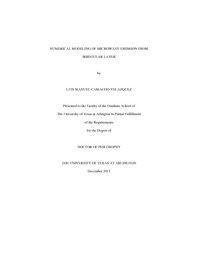| dc.contributor.author | Camacho-Velazquez, Luis Manuel | en_US |
| dc.date.accessioned | 2012-04-11T20:55:21Z | |
| dc.date.available | 2012-04-11T20:55:21Z | |
| dc.date.issued | 2012-04-11 | |
| dc.date.submitted | January 2011 | en_US |
| dc.identifier.other | DISS-11516 | en_US |
| dc.identifier.uri | http://hdl.handle.net/10106/9548 | |
| dc.description.abstract | A numerical approach to model the microwave emission from an irregular layer is developed. The phase matrix of the layer components as well as the emission characteristics are estimated using a numerical approach, namely the Finite-Difference Time-Domain (FDTD) method. The phase matrix is then integrated into a layer model that accounts for the scattering between the layer and ground, using the radiative transfer theory. The effects of interface roughness on emission are incorporated into the model through the surface phase matrices, which are computed using the Integral Equation Model (IEM).The validity of the phase matrices computation is tested against theoretical models. Similarly, the numerical model is validated by comparing its results with field measurements. For this purpose the components of the irregular layer are chosen to be corn stalks, represented by vertical dielectric cylinders. The bottom half-space bottom is chosen to be soil with rough surface. The microwave emission model predictions are then compared to those field measurements, showing a good agreement. | en_US |
| dc.description.sponsorship | Tjuatja, Saibun | en_US |
| dc.language.iso | en | en_US |
| dc.publisher | Electrical Engineering | en_US |
| dc.title | Numerical Modeling Of Microwave Emission From Irregular Layer | en_US |
| dc.type | Ph.D. | en_US |
| dc.contributor.committeeChair | Tjuatja, Saibun | en_US |
| dc.degree.department | Electrical Engineering | en_US |
| dc.degree.discipline | Electrical Engineering | en_US |
| dc.degree.grantor | University of Texas at Arlington | en_US |
| dc.degree.level | doctoral | en_US |
| dc.degree.name | Ph.D. | en_US |

